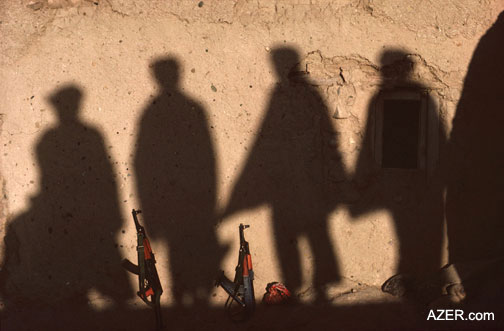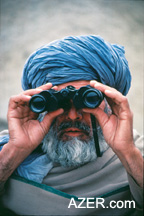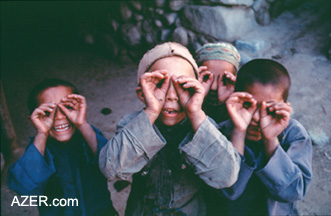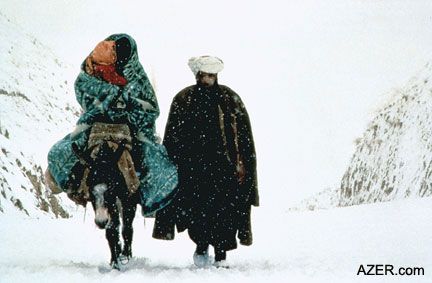|

Summer 2002 (10.2)
Pages
12-14
Reza - Focusing on Afghanistan
Other articles featuring Reza:
Black
January - Baku (1990) (AI 6.1, Spring 1998)
In
Pursuit of Freedom and Justice: Through the Eyes of a Photojournalist
- Reza (AI 6.1, Spring 1998).
Quotes: Baku-an
Old Forgotten Book (1997)
Quotes: Massacre
at Khojali (1999)
  Award-winning photojournalist Reza (1952-
), an Azerbaijani originally from Tabriz, Iran, recently held
two important photo exhibitions in the United States: an exhibition
and lecture at National Geographic in Washington, D.C. (May 7),
and another at the Open Society Institute's offices in New York
(May 13). Award-winning photojournalist Reza (1952-
), an Azerbaijani originally from Tabriz, Iran, recently held
two important photo exhibitions in the United States: an exhibition
and lecture at National Geographic in Washington, D.C. (May 7),
and another at the Open Society Institute's offices in New York
(May 13).
The two exhibitions focused on Reza's extensive work in Afghanistan.
Between 1983 and 1990, Reza traveled to Afghanistan several times
to cover the country's resistance to the Soviet occupation. He
became a personal friend of Ahmad Shah Massoud, the Northern
Alliance resistance leader who was assassinated two days before
September 11, 2001. In 1992, Reza was the only photographer to
enter into Kabul with Massoud.
"There's a curtain between
the photographer and the subject, and the photographer has to
be able to break through it," Reza says of his craft. "You
have to be passionate. You have to open your heart to people,
so they know you care. When I was covering Afghanistan, I lived
with the fighters in the trenches, eating what they were eating-that
is, if they had anything to eat."

Above:
Throughout the 1980s, Reza
photographed Afghanistan's resistance to Soviet occupation.
Reza has also spent a great deal of time photographing Azerbaijan
and the Caucasus region. When Soviet troops massacred Azerbaijani
civilians in the streets of Baku in January 1990, Reza was there
to document the tragedy and break the news about Black January
to the Western press. [For more, see the article "Black
January: Behind the Scenes - A Photojournalist's Perspective"
in AI 6.1 (Spring 1998).]
  Reza also spent nearly two years traveling
throughout Azerbaijan, Russia, Kazakhstan and Turkmenistan to
document the Caspian Sea for National Geographic's May 1999 issue. Reza also spent nearly two years traveling
throughout Azerbaijan, Russia, Kazakhstan and Turkmenistan to
document the Caspian Sea for National Geographic's May 1999 issue.
"When I was just 14, I realized that photography was really
where my heart was," Reza says, "but I never thought
that I would be a professional photographer." He began to
teach himself the principles of photography but later studied
architecture at the University of Tehran.
Right: Reza was a close friend of Shah Massoud,
shown here, the Northern Alliance leader who was assassinated
on September 9, 2001, two days before terrorists attacked the
NY World Trade Center and the Pentagon.
His interest in photojournalism was sparked during the demonstrations
in Iran in 1978. "One afternoon, I saw some students demonstrating
in the street against the Shah," he recalls. "One of
the students had a camera. As he was running way from the soldiers,
he was taking pictures. And I thought, 'Well, Reza, something's
happening in your country. What are you going to do?' So I decided
to become a professional photographer.
"One day there was a big demonstration in Tehran. All the
press agencies and magazines had photographers there. A French
agency asked me to shoot for them for one day. A few days later,
I got a phone call from Paris: 'Congratulations! You have six
pages in Paris Match, six pages in Stern and a big picture in
Newsweek.' I said, 'What? Are you sure they're my pictures?'"
Before long, Reza's work for the French Press Agency had earned
him a position as a Newsweek correspondent in Iran. When the
Iranian hostage crisis began, he was the only photographer there
to witness what was going on outside of the U.S. Embassy. His
photos of the American hostages appeared in numerous magazines
around the world.
  
Right: An Afghan guerrilla fighter resisting
the Soviet occupation, 1980s.
Left: Children from Afghanistan's Nangrahar
Province playfully imitate Reza's camera.
Reza doesn't use his last name professionally because his dissident
photographic activities have often made him a target for authorities.
He explains: "When I was 22, I was arrested by the police
for making newspapers and taking pictures that were against the
government. I was put in prison for three years. I was tortured
for five months-they were trying to find out if I belonged to
a conspiracy. Later, when I covered the Iran-Iraq War and the
Kurds in Iran, my pictures of the Kurds made the government very
angry with me again. That was the beginning of my exile. I haven't
been able to return home to Iran since March 1981."
Below: A family traveling together during
a blizzard, Afghanistan.
  Besides working as a Middle East correspondent
for Time magazine from 1983 to 1988, Reza has undertaken several
assignments for National Geographic in Egypt, Turkey, the Caucasus,
Central Asia, Russia and China. He has contributed to a number
of books, is a regular correspondent for BBC Persian and Radio
France Internationale Persian and has taught at such schools
as the École d'Art in Paris and Georgetown University
in Washington, D.C. Besides working as a Middle East correspondent
for Time magazine from 1983 to 1988, Reza has undertaken several
assignments for National Geographic in Egypt, Turkey, the Caucasus,
Central Asia, Russia and China. He has contributed to a number
of books, is a regular correspondent for BBC Persian and Radio
France Internationale Persian and has taught at such schools
as the École d'Art in Paris and Georgetown University
in Washington, D.C.
While Reza makes his home in Paris, he is often traveling throughout
the world documenting the horrors of war. He compares the various
worlds that he lives in-Paris and Washington, D.C.-to the sinking
of the Titanic. "We're living on a big ship during the best
of times. We're enjoying grand parties, great food and wonderful
friends. But this ship is surrounded by blood and famine and
disaster. I feel like I'm one of those people living on that
ship and from time to time, I slip out into the water. After
a while I return and try to explain, 'Hey, there are people out
there who are dying. We should do something about it.' And when
I see that people aren't taking me seriously, I remind them of
what happened on the Titanic. One day, if we don't take care
of those in the deep, dark, icy waters, it could happen to us."
One of Reza's most important causes is the children's rights
project he started ten years ago. "In the 1980s, when I
was covering war zones in Afghanistan, Beirut, the Philippines
and South Africa, I realized that the real victims of war were
the children," Reza says. "They are so innocent that
they don't understand why this is happening to them-why they
are losing their homes and their families, why they don't have
anything to eat. I decided to focus my camera on this to show
it to the world."
From 1989 to 1990 Reza served as a consultant to the United Nations
humanitarian program in Afghanistan. He is also the founder of
AINA, a non-profit foundation for the development of independent
media and cultural expression in Afghanistan. The organization's
sponsors include UNESCO, Reporters Sans Frontières, USAID,
DFID (the British government's Department for Internal Development),
International Media Support (IMS) and private sources. (To learn
how to help AINA, send an e-mail to info@ainaworld.org or visit
www.ainaworld.org.)
For more about Reza, see his
Web site, WEBISTAN.com,
and the articles "Black
January - Baku (1990)" and "In
Pursuit of Freedom and Justice: Through the Eyes of a Photojournalist
- Reza" in AI
6.1 (Spring 1998).
____
Back to Index
AI 10.2 (Summer 2002)
AI Home
| Magazine
Choice
| Topics
| AI Store | Contact us
Other Web sites
created by Azerbaijan International
AZgallery.org | AZERI.org | HAJIBEYOV.com
|






